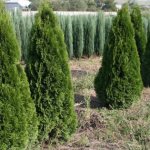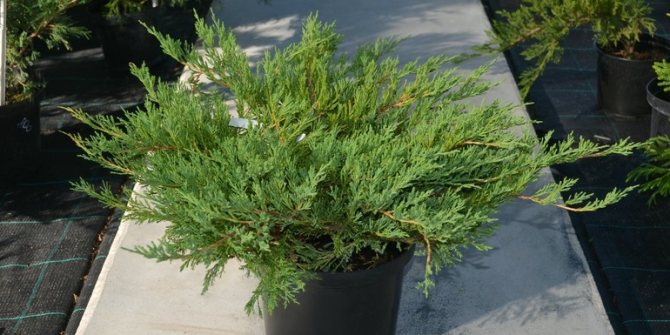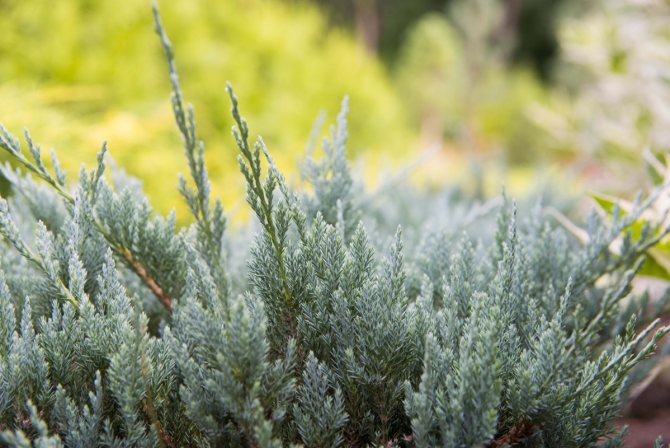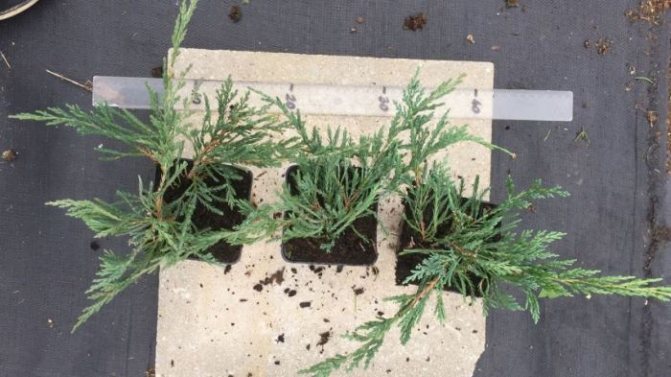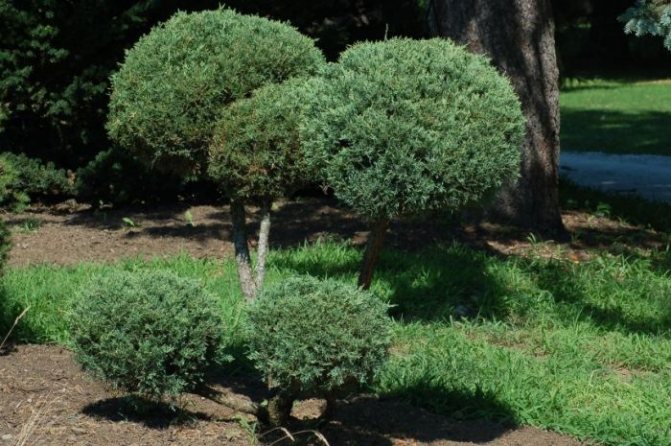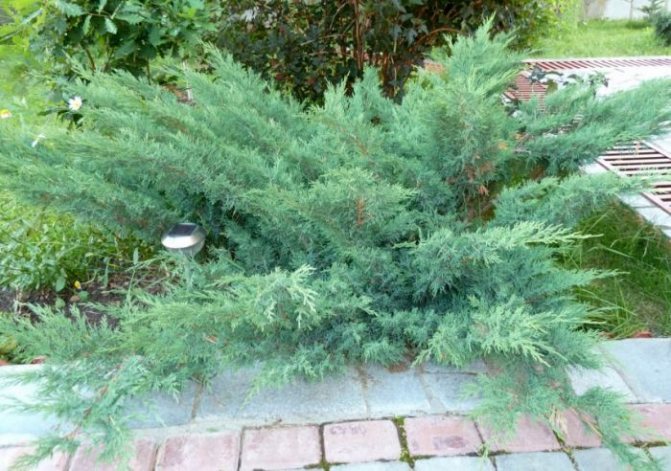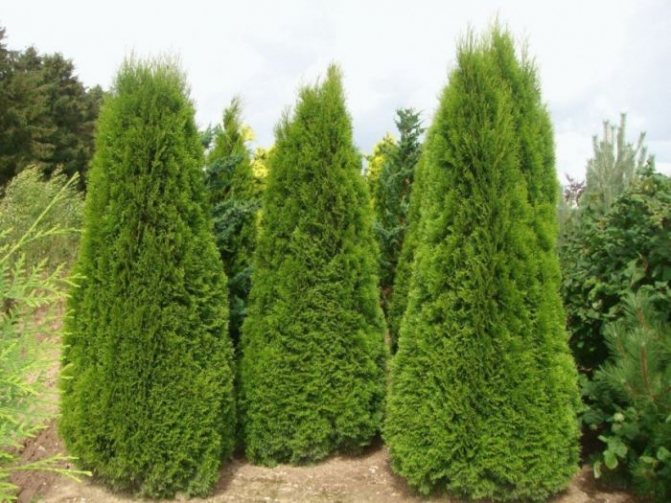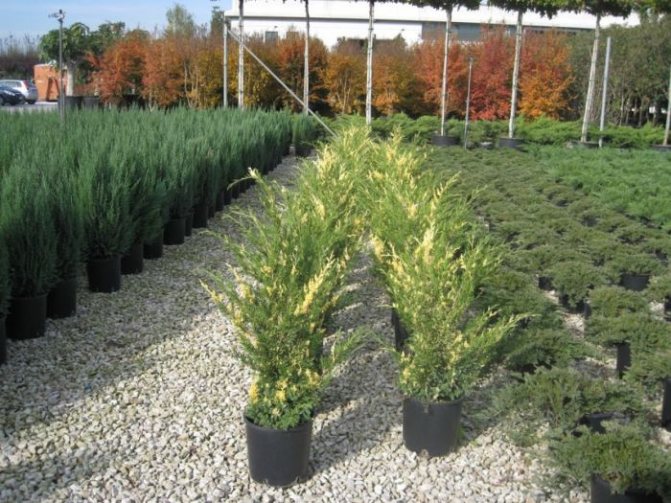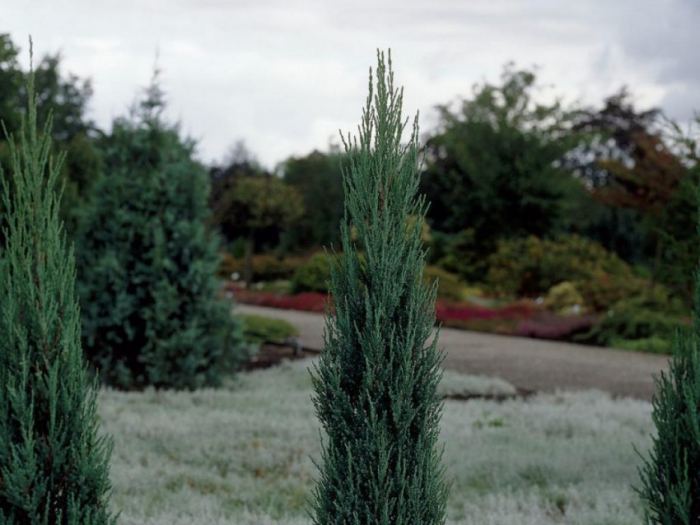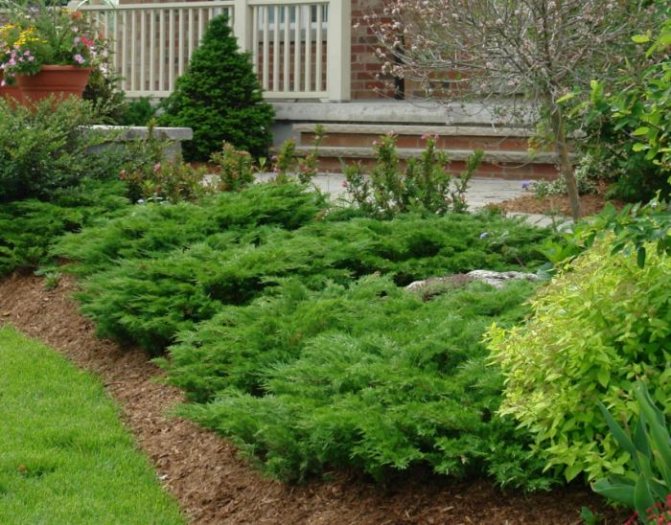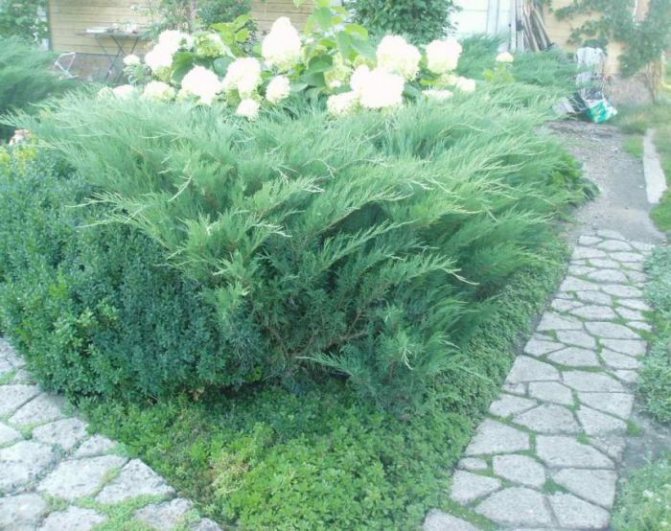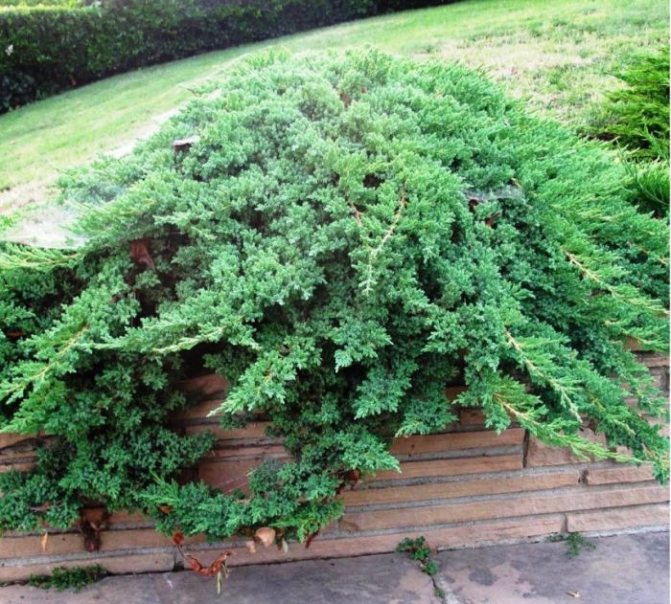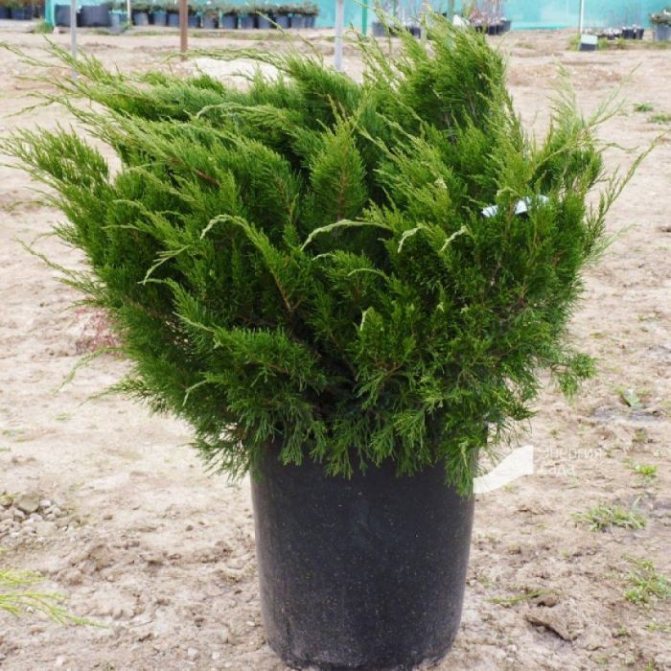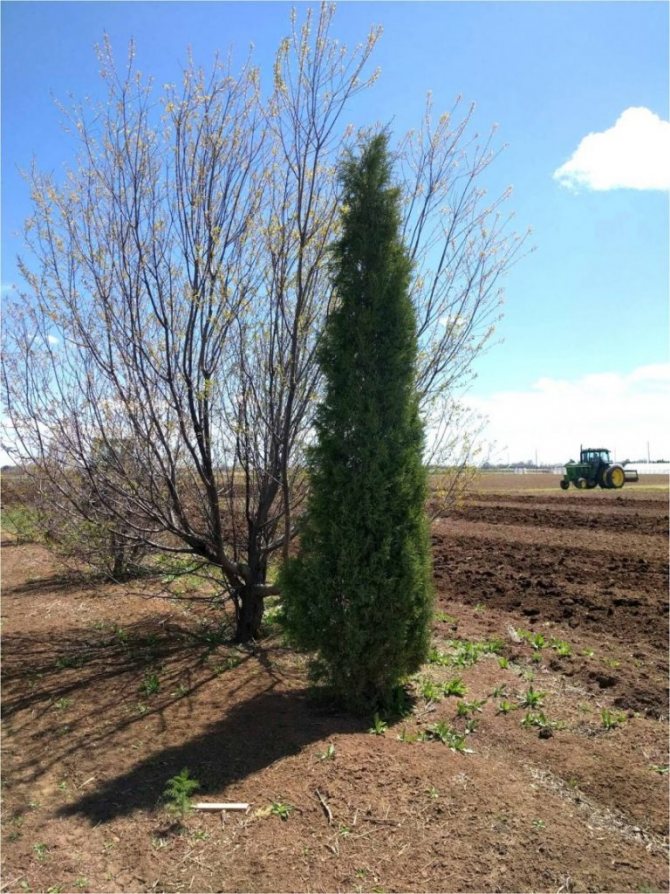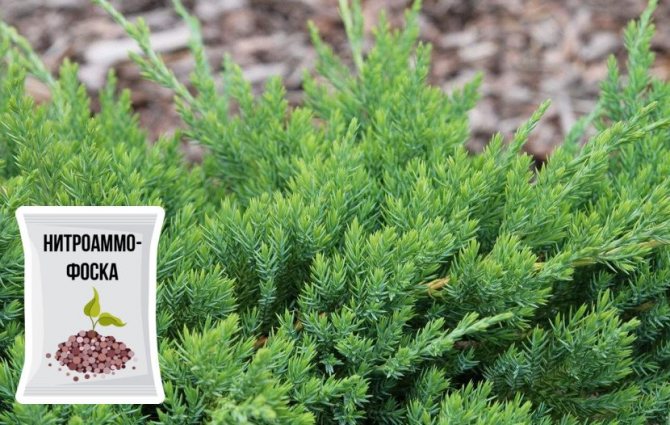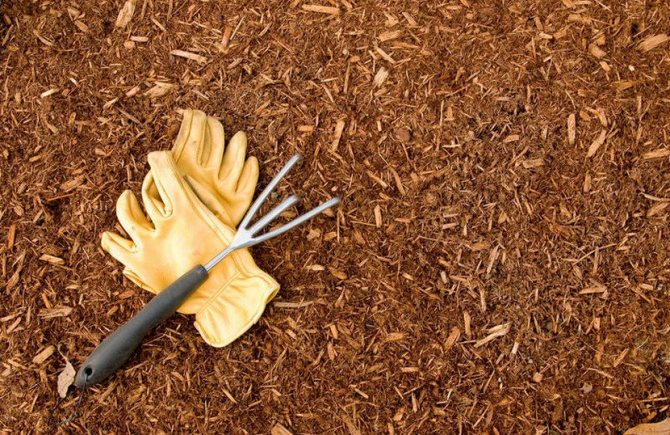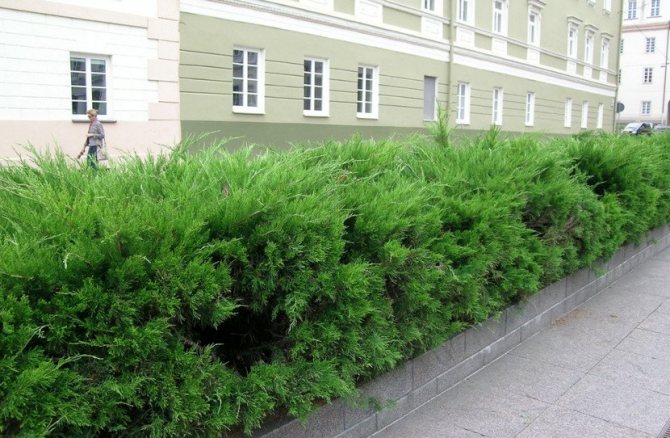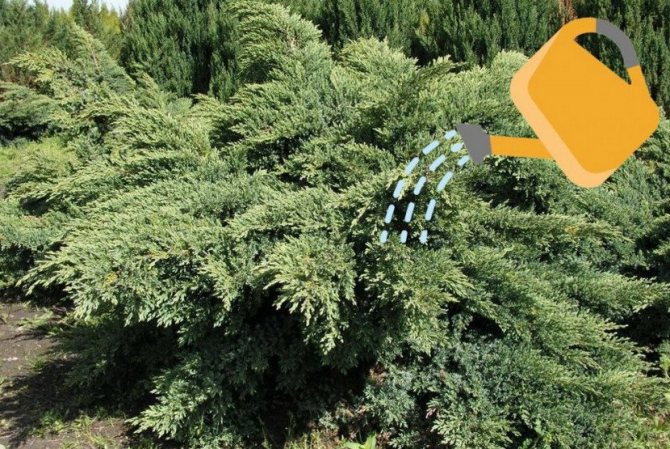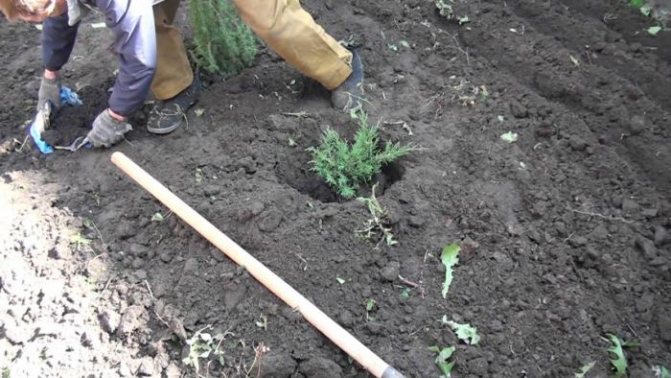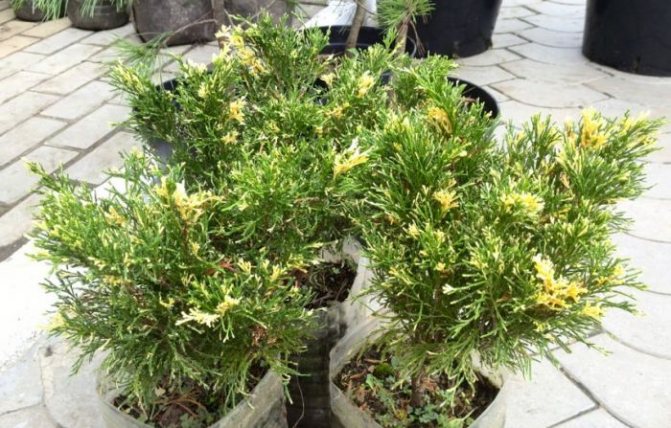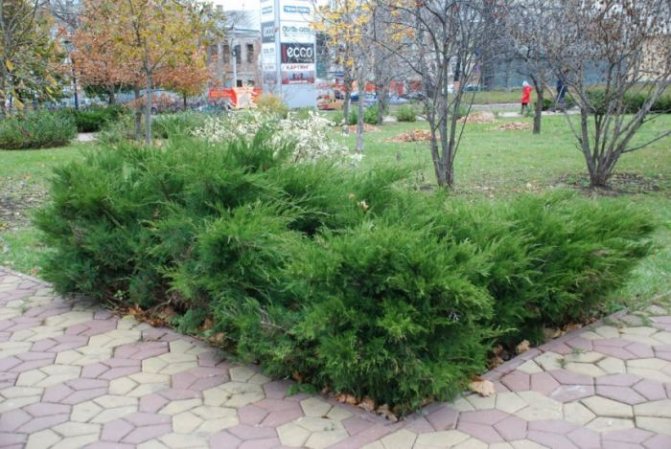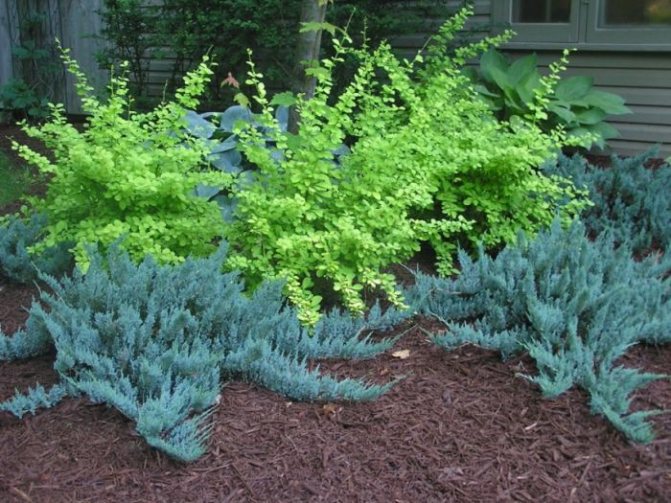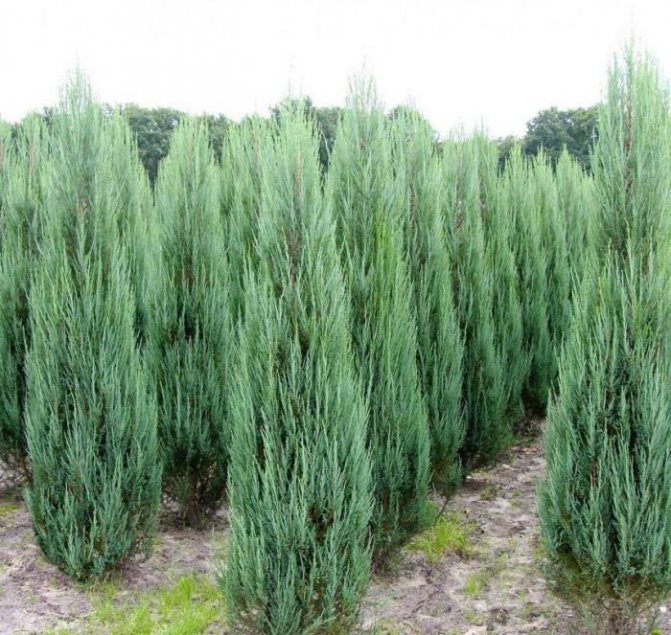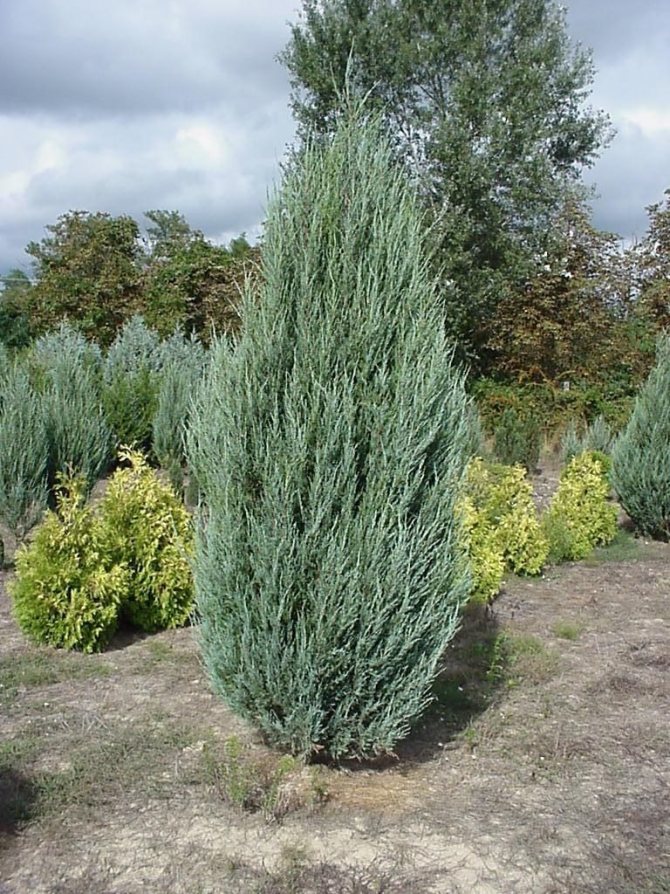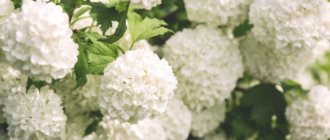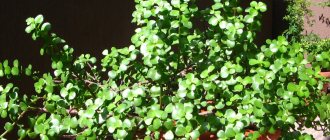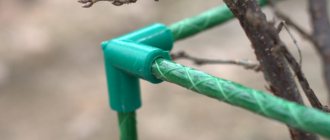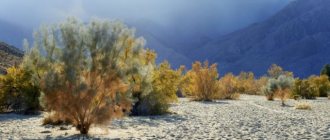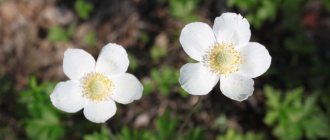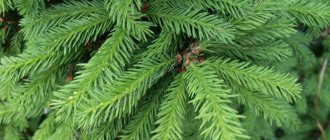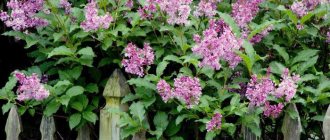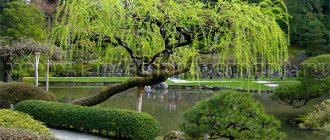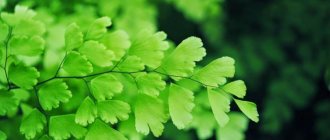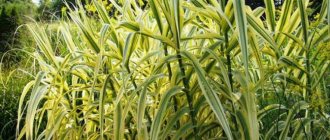Juniper belongs to a variety of cypress evergreen trees and shrubs. This type of ornamental culture is used to create regular style flower beds. The plant has a lush green crown throughout the year. Depending on the variety, its height varies from 0.5 to 5 m.The width of the spreading crown is up to 4 m.
In nature, more than 15 varieties of juniper are distinguished. Each of them differs in color and shape of coniferous needles. In young shoots, the bark has a light orange tint. The leaves are needles, collected in small brushes, the bark forms a kind of fan. This type of shrub is a dioecious plant.

Juniper Daursky: description of the variety
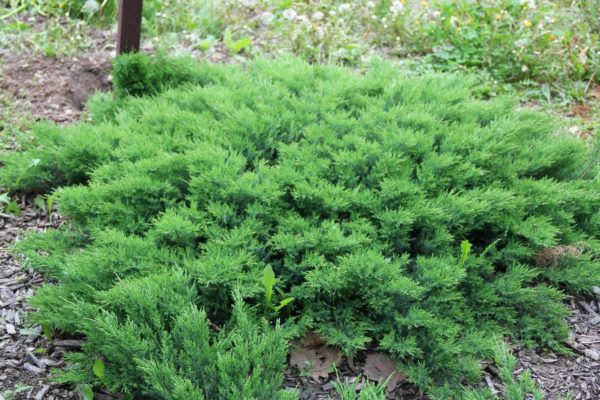

Juniper Daursky: photo
This juniper is considered a low-growing shrub, its branches spread over the surface of the earth, so it does not grow more than 50 cm in height.The central stem of a juniper is hidden deep in the ground, so outwardly we can say that shoots grow directly from the root. Moreover, each branch forms almost a separate plant, however, the root system of the juniper is common.
This variety also grows slowly, so this plant becomes an adult and mature bush only at the age of 5 years. The growth at this time is also insignificant, no more than 6 cm per year. The shrub usually grows no more than 50 cm in height, and a little more than 1 meter in width. The twigs form the crown like a round dome, so this juniper looks great in any garden. When the branches grow 7 cm in height, they begin to creep along the surface of the earth. When the shoots come into contact with the topsoil, they begin to take root. In the future, these layers can be separated from the mother bush and transplanted to a new location.
When the bush becomes completely adult, the growth will be even slower, no more than 1 cm per year. In one place, this culture can grow for more than 50 years, so this plant is rightfully considered a long-liver. This culture is unpretentious to care for, so this ornamental shrub is often used by designers to decorate the landscape. In addition, the bushes are very frost and heat resistant. Juniper can not be watered for a long time, plants also feel great in the shade. Juniper branches are thin, about 3 cm in diameter at the base. Towards the top, the shoots are tapering, the crown is prone to narrowing, it is usually gray in color, the needles are scaly, light green in summer, dark burgundy closer to winter. At the tops of the branches, the needles grow in the shape of a rhombus, but closer to the base they gather in whorls in two pieces.
The juniper has berries that are quite round, dark gray in color, sometimes with a brown tint. On the surface of the bumps, you can see a silvery coating. Juniper does not bear fruit every year, and usually few ovaries are formed. This culture also produces seeds, in one berry usually no more than 4 pieces.
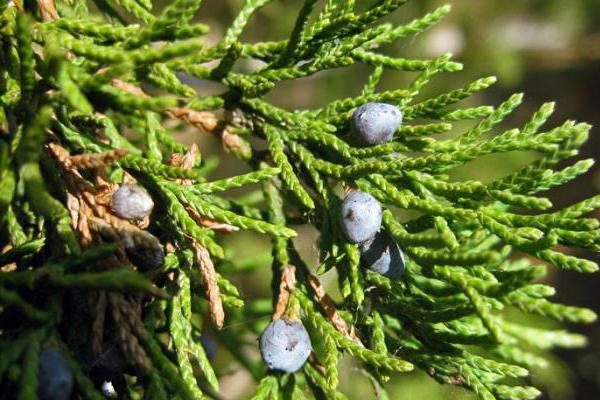

The root system of plants is well spreading and developed, so it grows intensively in the surrounding space. Often the Daurian juniper is used as a seasoning, its needles and cones are added to fish dishes.As you know, juniper has a great effect on the surrounding atmosphere, thanks to essential oils, the twigs smell very nice, so pine needles are often added to alcoholic drinks for a special aroma. Juniper is also effectively used in cosmetology.
Designers love this plant very much, this frost-resistant bush practically does not need to be looked after, therefore, having planted it on your site, you can forget about leaving once and for all. But the growing branches very often resemble a lawn, so if you wish, you can have your own evergreen natural carpet in your country house. Juniper fits perfectly into the surrounding space. He has wonderful decorative species, the needles are bright green, and burgundy in autumn.
In addition, due to the fact that the plant grows slowly, the bush does not need to be shaped and cut. Often this culture is used for landscaping flower beds and personal plots. It can be planted next to office buildings, in park areas. Designers often create real alpine slides from this variety of juniper, as its shoots spread beautifully along the ground, and if you plant a juniper on a slope, it will descend in a beautiful green cascade. The shrub is often planted near large stones, on the banks of water bodies, as well as next to other decorative and flowering crops. You can create a real green hedge from this shrub. Juniper also looks great in pots.
Place and time of boarding
The landing site should be sunny and light. When growing in full shade, the plant will deform the crown. It will become loose, sloppy.
Juniper is planted in spring (April, May) and autumn (September, October). Provided that the plant was purchased grown in a container, it can be planted in the summer. When planting in summer, the tree is shaded all season from direct sunlight and is often watered.
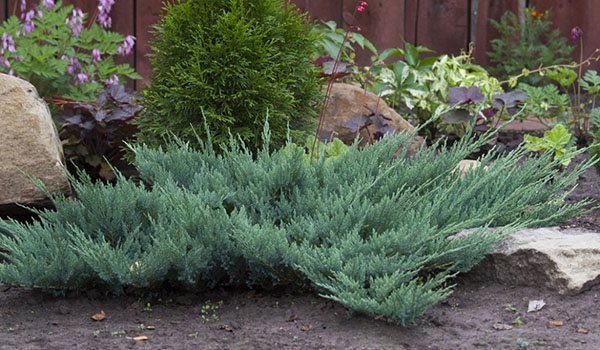

Juniper
Note! The best age for planting a juniper in a permanent place is 3-4 years. Older seedlings will take longer to adapt.
The clod of earth on the root system must remain intact. Scattering of soil will injure the roots, which in turn can contribute to disease and death of the plant. Before planting, the container with the seedling is dipped in water to soak the coma. It is best to plant junipers when the weather is cloudy.
About Dahurian juniper varieties
Juniper has two main varieties. These types differ in color and shape of the needles. They are much less common in the wild than the traditional type of juniper, however, these varieties are often used to decorate sites.
- The first variety is Daurian juniper Leningrad leningrad This is a completely dwarf shrub, because it is lower than Daurian. Its twigs settle on the surface of the earth, and reach 2 meters in length. His crown is dense, shoots usually completely sink to the soil surface. Where the twigs touch the ground, the roots begin to form in the juniper. His needles are quite small, and the needles are very thick. The color is traditional, and the needles are rather prickly. This juniper can grow on a variety of soil types. His growth is also small, usually from 5 to 7 centimeters per year. Moreover, over the years, the growing season slows down even more. With the help of the Daurian juniper Leningrad, you can arrange a border near the road, as well as plant it in various group compositions. He loves moist soil as well as open areas.
- The second type of Daurian juniper - expansa variegata... It is also an ornamental shrub, but its branches are straighter, they intertwine very tightly, so it is almost impossible to separate them. The height of this shrub is also small, but the length of the shoots is slightly longer than that of the Daurian juniper Leningrad, more than 2 m. Its needles are two-colored, the needles are blue and cream.Essential oils in needles are contained in large quantities, therefore this juniper effectively destroys all pathogenic microorganisms that are in the air within a radius of several meters. It is also unpretentious, frost-resistant. It takes root on different types of soils. It is often planted in parks, sanitary zones, as well as in flower beds and personal plots. Juniper is beautifully located near various buildings, enriching the air with essential oils.
Use in landscape design
Daurian juniper, undemanding to conditions, is an excellent coniferous plant, it is popular in landscape design. The creeping cover shrub is interesting in that it looks like the background, the lower layer of the general picture of both the urban park area and the private garden. The species can be used in rock gardens, its shoots descend beautifully along rocky slopes.


A stunted bush looks interesting as a decoration for the banks of a small reservoir. Such decorative representatives of conifers look great as a detail of landscaping architectural forms. The roofs of buildings, various stone structures and even fences can be decorated with flowerpots and containers with a plant.
Did you know? In Russia, juniper bark was used to make dishes in which milk did not spoil.
Daurian juniper will surely please not only professional gardeners and designers, but also summer residents, lovers of green spaces. Making a personal plot, flower bed, any complex area does not require much effort. This comfortable coniferous species of the Cypress family is an ideal piece of landscaping.
Planting Daurian juniper
It is best to plant a juniper on a southern slope; this plant feels great in open areas or in partial shade. If you plant a tree in a completely darkened area, it can stretch out and chop the needles. Moisture is well preserved under this dwarf bush, so there is no need to water the juniper intensively. It is best to plant this crop on neutral or slightly alkaline soil. It is best to choose a well-drained, loose area. If you plant a juniper near a fruit tree, the parasite of rust may be the parasite of needles. Juniper is propagated in different ways.
You can easily prepare the planting material yourself, so if a juniper bush is already growing on your site, then it is easy and simple to propagate the plant, usually planting work is carried out either in spring or in autumn. Do this before the onset of frost. If you buy seedlings from the nursery, then carefully examine the root, it should be free of defects and traces of drying out. The needles on the branches should also be dense. If you are going to transplant the bush to another site, then it is advisable to first raise the branches and collect them in a bunch, fix them with a rope and cover them with fabric. This is necessary so that the shoots are not damaged during transportation. It is necessary to dig in the bush, stepping back from the plant about 35 cm. It is necessary to deepen at least 30 cm. It is advisable to remove the bush together with the earth lump. Then it is best to put it on a piece of burlap, remove excess soil and transfer it to a new habitat.
The site should also be prepared there. For this, it is advisable to dig up the soil, remove all weeds. The planting hole should be at least 60 centimeters deep, remember that it should also be wider than the root system of the seedling. Peat and sand are usually placed there, a drainage layer is lined on one. For this, expanded clay or large crushed stone is often used. Before planting, the root system is placed in a growth stimulator for a couple of hours. In the soil, as you remember, it is advisable to add peat and sand, and you can also sprinkle a little lime. Juniper loves alkali.
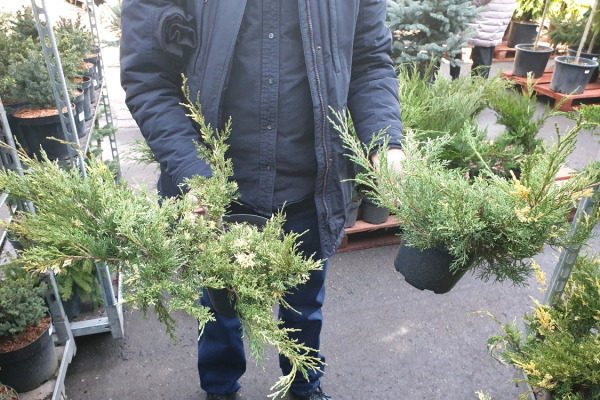

The seedling should be installed in the center, and then cover the free space with earth, the root area will need to be well compacted and watered. After that, the crown can be freed from the fabric, and the branches can be evenly identified along the surface.Planting junipers should not be very close to other plants, keep some distance.
Landing on a site in open ground
Before planting, the plant brought to the country house, together with the pot, is immersed in a container of water for several hours. While the root ball is wet, prepare the planting pit. We make it twice the volume of the pot in which the seedling was purchased. We spill the hole with water, pour a mound of garden soil on the bottom, install a plant freed from the container on it, slightly straightening the roots. Align vertically and fall asleep without deepening the root collar. We compact the soil, water and mulch again. For columnar varieties, the installation of stretch marks is required.
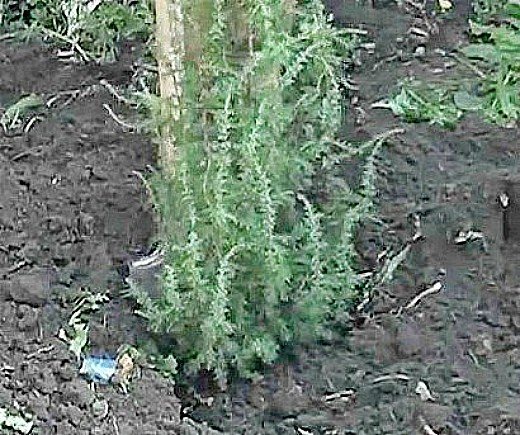

Juniper Daursky: variety care
As you remember, this culture is unpretentious, so it does not require special attention, however, certain rules should still be followed. Form a crown, remove weeds and water the plant in time. This culture is not demanding for watering, so you can moisten the soil every other day, and it is best to do this in the evening. But this applies only to young plants, an adult juniper is practically not needed for watering. Since under a continuous carpet of needles, moisture persists for a long time, even in dry summers. But young seedlings should be watered within 2 months.
It is usually recommended to feed the crop in the first two years; in early spring, fertilizer is usually not applied under adult bushes. It is advisable to mulch the trunks after plant transplantation. To do this, use tree bark, sawdust, dry grass. Moreover, the mulch should be renewed every year. And they usually do it in the fall. Around the soil must be loosened in time, and weeds must be removed. But all this should be done only around young seedlings; adult bushes do not need weeding. Their shoots grow so intensively that weeds simply do not grow, and the mulch perfectly retains moisture, and also allows air to pass through well.
Dahurian juniper should be pruned in the spring, for this it is recommended to remove diseased and dry branches in time. If the wintering was successful, then the plants should not be cut off; designers are usually engaged in the formation of the bush in order to create bizarre sculptures from the crown of the culture. But remember that juniper branches grow extremely slowly, so don't prune them too much. Once a year it will be enough to form the crown of the bush.
Moisten the soil abundantly before wintering. In addition to the root, add a couple of centimeters of mulch. But just before the arrival of winter, young bushes have branches usually collected in a bunch and fixed. This should be done so that they do not break under the weight of the snow. Shelters are also erected over young plants. For this, spruce branches, another covering material, are often used. In winter, don't forget to throw snow on the bushes. If we talk about adult bushes, then it should be noted: they should not be covered, they winter well without artificial structures.
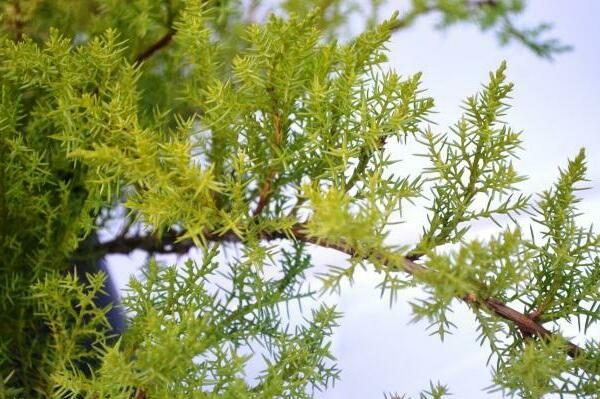

Chinese Juniper (Juniperus chinensis)
It grows naturally in China, Mongolia and Korea. Most often, a creeping shrub with dark green, predominantly scaly needles. The cones are almost oval, dark blue, almost black.
Juniper Chinese Blue Alps
Erect, slow-growing shrub, up to 2.5–4 m in height and 2 m in diameter, with a compact dense crown and hanging shoots. The needles are bluish-green above, silvery below. Sunburn.
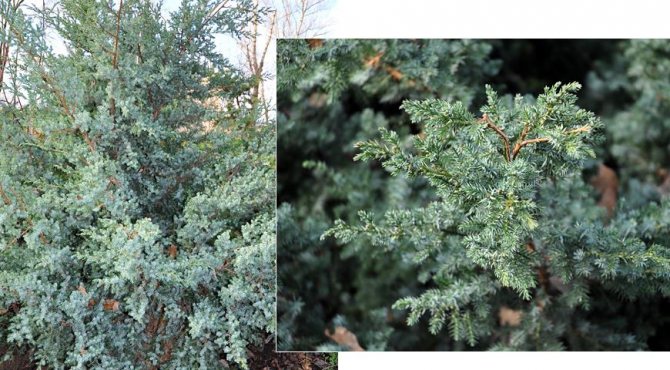

Juniper Chinese Blue Alps
Juniper Chinese Expansa Variegata
Shrub at 10 years of age, about 0.3 m in height and 1 m in diameter. The needles are green, the tips of the shoots are white-cream, in winter with a bronze tint.
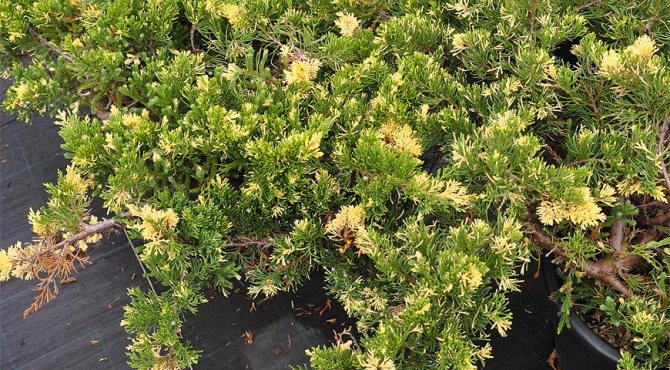

Juniper Chinese Expansa Variegata
Juniper Chinese Kuriwao Gold
A shrub with a spreading spherical crown, at the age of 10, up to 1.5 m high and up to 2 m in diameter. Young needles are yellowish-green, mature green.
Juniper Chinese Spartan
Fast-growing shrub, up to 3-5 m high, with a columnar crown, which eventually becomes wide-pyramidal. The needles are green.
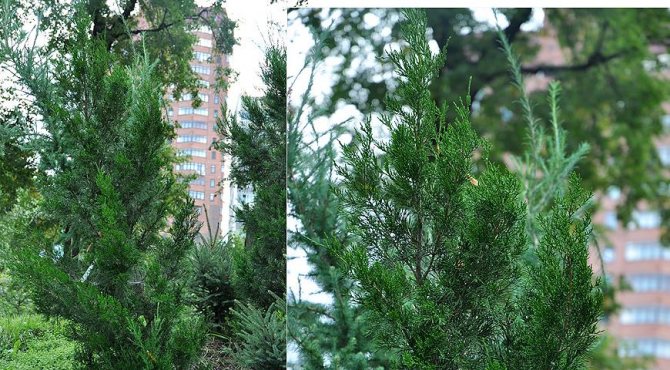

Juniper Chinese Spartan
Juniper Chinese Torulosa VarieMata (Kaizuka Variegata)
Slow-growing shrub, at the age of 10, up to 0.9 m high and 0.6 m wide. The needles are blue-green with creamy white blotches. In a sunny place, the variegation is more pronounced.
Juniper Chinese Plumosa Aurea (J. pfitzeriana Plumosa Aurea)
Erect shrub, 2-3 m high and up to 3-4 m in diameter, with an uneven crown. The needles are yellow, bronze-yellow in winter.
Juniper Chinese Stricta
Slow-growing dwarf tree, by the age of 10, up to 1.5 m high and 0.5 m in diameter. The crown is conical, the shoots grow vertically, the needles are green-blue.
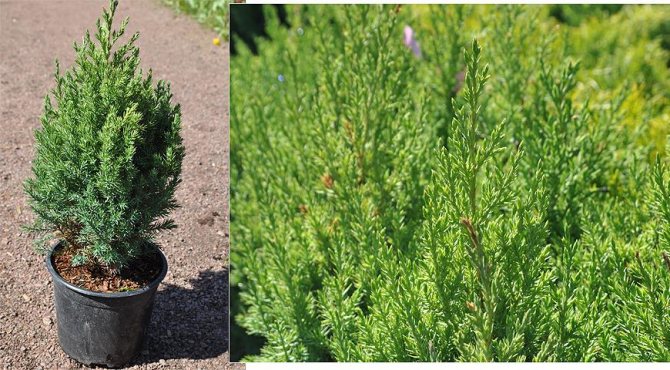

Juniper Chinese Stricta
About the reproduction of juniper
Since the Daurian juniper usually spreads over the surface of the earth, it can be effectively propagated by layering; for this, you will need to dig in a young two-year-old shoot, cover it with loose soil on top. After a while, additional roots will appear on the branch, but after a year, the shoot can be separated from the mother bush and planted in a new place.
You can also use cuttings, for this you will need to separate 15-20 centimeter shoots from three-year shoots. After that, they are placed in moistened soil and are waiting for the appearance of roots. With the help of grafting, Daurian juniper is rarely propagated, since this material does not take root well on other stamps. Seed propagation is considered the most time-consuming process, so gardeners usually choose either cuttings or cuttings.
Characteristics and peculiarity of juniper
When you touch the leaves, you can feel the tart coniferous aroma that remains on the fingers for a long time. After flowering, capsules are formed in the form of small cones with seeds. On average, 15 to 25 pieces are collected here. seed planting material.
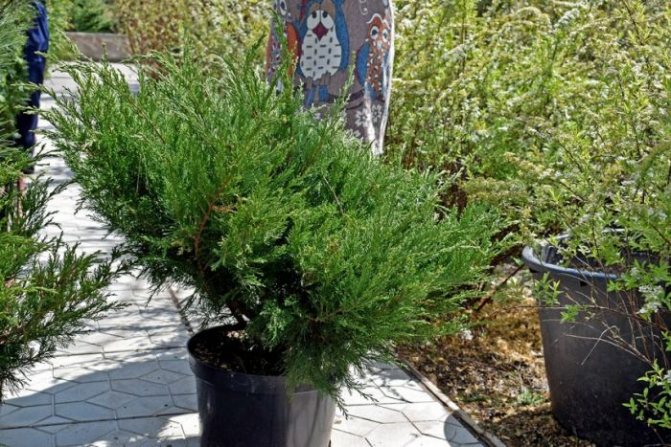

Male cones are oblong and elongated. They have a bright brown color. As a rule, the seeds are located near the leaf sinuses. The full maturation of such cones is noted already in the second year of the plant's life.
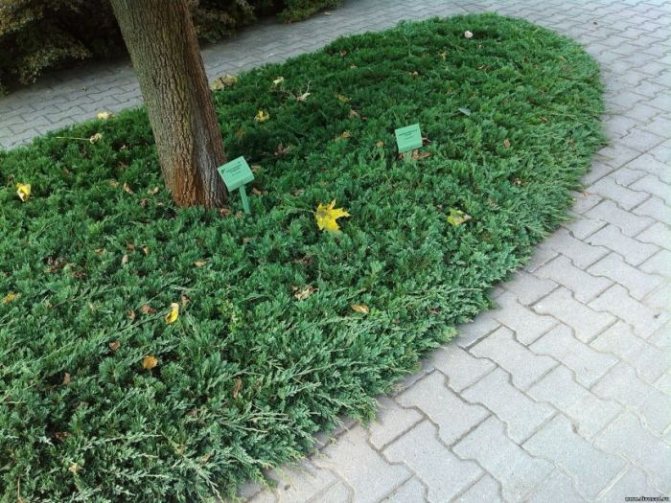

This variety can be grown both outdoors and on a windowsill. Juniper bonsai is especially popular among flower growers. In the process of plant growth, the upper leaves are removed, thereby forming the required crown volume.
About diseases and pests
It is no secret that Dahurian juniper secretes substances that garden pests do not like, therefore insects practically do not parasitize on needles. However, sometimes aphids, scale insects, spider mites and sawflies settle on junipers. In order to get rid of these pests, gardeners remove insect larvae, collect pests by hand, treat bushes with insecticides, as well as colloidal sulfur.
If necessary, you can always visit a specialized store and find the necessary drug. As you remember, if fruit trees grow next to the juniper, then the needles can be affected by rust. Therefore, choose your neighbors correctly, fungal infections are also not needed for juniper.
Juniper Cossack (Juniperus sabina)
In nature, it grows on the slopes of the mountains of Crimea, the Caucasus, Mongolia, Central and Western Europe. Shrub up to 1.5 m high and up to 5 m wide, rarely erect shrub or tree.
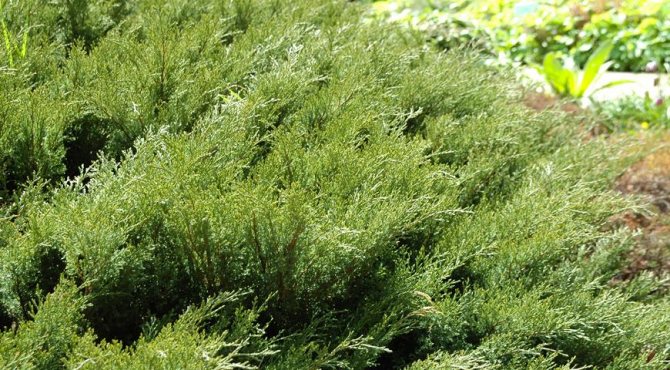

Juniper Cossack
Rounded cones are brown-black with a bluish bloom. It has been known in culture since 1580.
Juniper Cossack Variegata
Creeping shrub, up to 0.6-1 m high and up to 1.5-2 m in diameter. Gray-green needles with cream strokes.
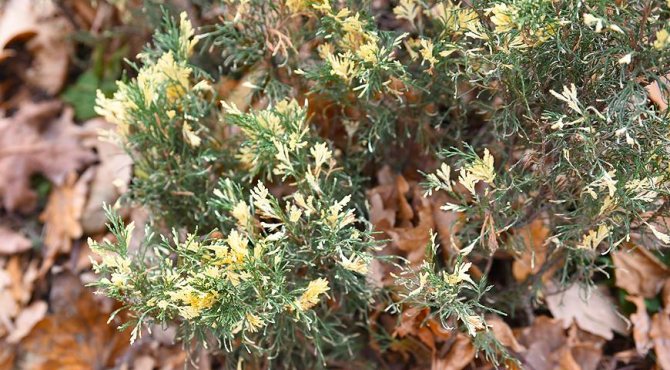

Juniper Cossack Variegata
Coastal or crowded juniper (Juniperus conferta)
It grows naturally in Japan and Sakhalin. A creeping shrub with very long branches rising at the ends.The needles are dense, light bluish-green, very prickly. The cones are dark blue with a bluish bloom.
Juniper coastal Allgold (All Gold)
Slow-growing form, with yellow needles, turning green in the shade, up to 0.2 m high and up to 1 m in diameter.
Juniper Coastal Blue Pacific
A fast-growing form, up to 0.3–0.4 m in height and up to 1 m in diameter. The needles are bluish-green. Can be grafted onto a stem.
Juniper coastal Schlager
Squat, spreading shrub up to 0.3 m high and up to 1 m in diameter. The needles are long, prickly, light green in color.
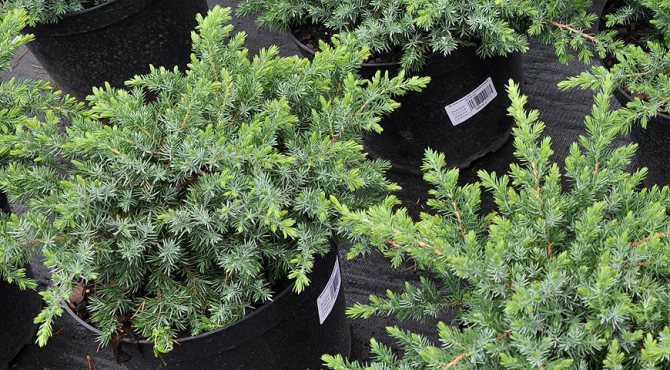

Juniper coastal Schlager
Juniper Pfitzer (Fitzer), or medium (Juniperus × pftzeriana)
A hybrid of Chinese and Cossack junipers. The most widespread and popular group of junipers in the world. Shrub up to 2 m high, with a spreading crown. The needles are scaly and needle-like. It should be noted that in severe winters in the Moscow region, many varieties have noticeable damage. Preferably a sheltered landing site.
Pfitzer Juniper or Medium Blue and Gold (Blue Gold)
Slow-growing shrub, up to 1 m in height and up to 1.5 m in diameter. The needles are bluish-green with golden-yellow blotches.
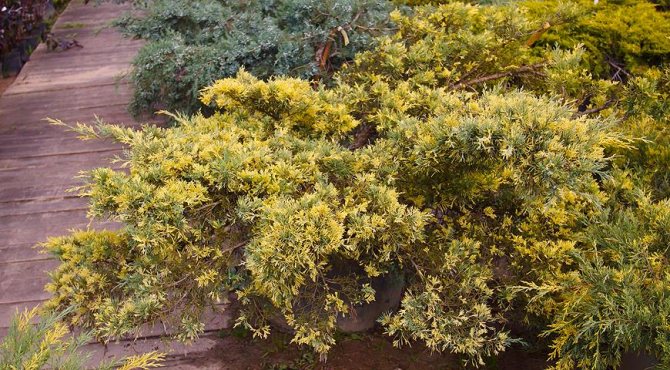

Pfitzer Juniper or Medium Blue and Gold (Blue Gold)
Pfitzer Juniper or Medium Carbery Gold
A low-growing shrub with a spreading crown and a golden shade of needles. The shoots are open, the ends are slightly hanging down.
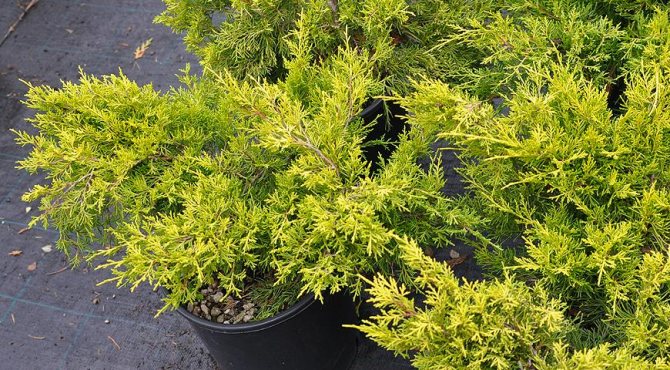

Pfitzer Juniper or Medium Carbery Gold
Pfitzer Juniper or Medium Gold Coast
Shrub up to 1 m in height and up to 3 m in diameter, with a dense crown. The needles are yellow at the tops of the shoots, darkens in winter.
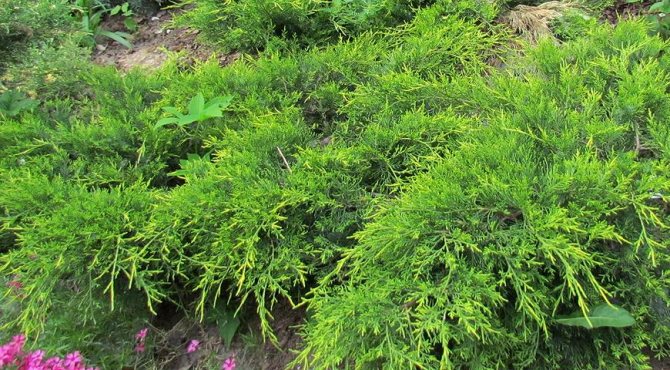

Pfitzer Juniper or Medium Gold Coast
Pfitzer Juniper or Medium Gold Star
Slow-growing shrub, up to 1 m high and up to 2.5 m in diameter. Golden needles.
Pfitzer Juniper or Medium Old Gold
Slow-growing shrub, up to 1 m high and up to 2.5-3 m in diameter. Scaly-needle needles, permanent golden color.
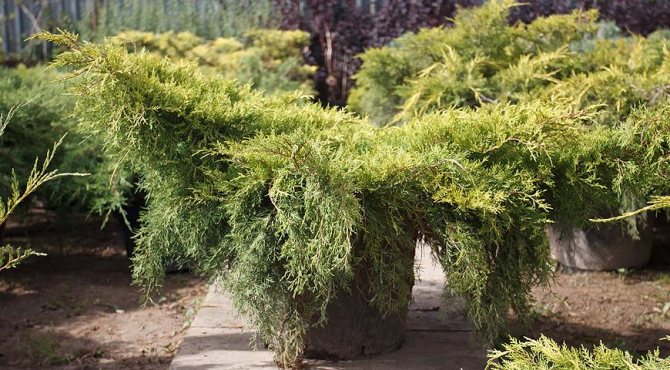

Pfitzer Juniper or Medium Old Gold
Pfitzer Juniper or Medium Pfitzeriana Aurea
A fast-growing shrub, up to 2.5–3 m high and up to 3.5–5 m in diameter. The crown is prostrate, raised over time. The needles are scaly and needle-like, yellowish-golden on young shoots, later turning green.
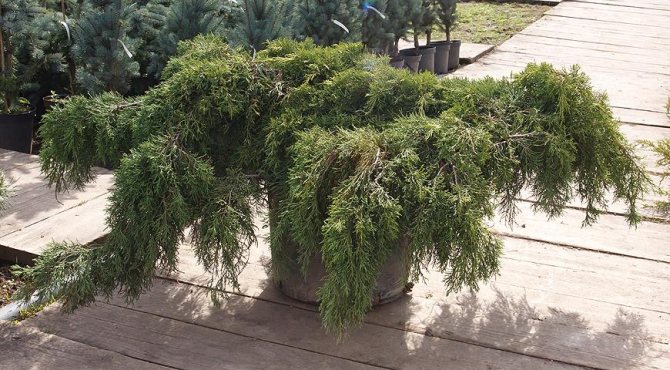

Pfitzer Juniper or Medium Pfitzeriana Aurea
Pfitzer Juniper or Medium Pfitzeriana Glauca
Shrub up to 1.5 (2.5) m in height and up to 3 m in diameter. The needles are bluish-green.
Scaly juniper (Juniperus squamata)
A dioecious, less often monoecious creeping shrub, grows naturally in the mountainous regions of East Asia. The needles are needle-like, very tough. Oval cones are black, glossy.
Juniper scaly Blue Carpet
Popular Dutch variety. Creeping shrub, 0.3–0.5 m high and 1.5–2.5 m in diameter. The needles are blue, sharp, but not prickly.
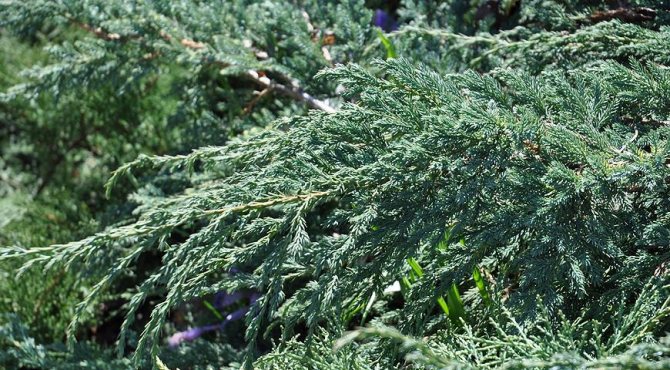

Juniper scaly Blue Carpet
Juniper scaly Blue Star
Dwarf slow-growing shrub, up to 0.5 m high and up to 1.5 m in diameter. The needles are silvery-blue.
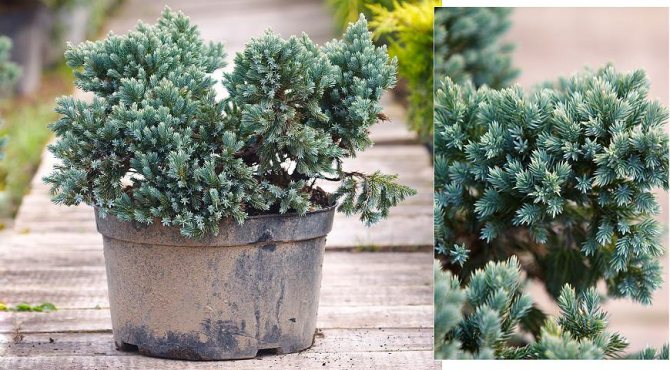

Juniper scaly Blue Star
Juniper scaly Floreant
Slow-growing shrub, up to 0.5-1 m high and up to 1.5 m in diameter, with a spherical crown. The needles are blue with light creamy splashes.
Juniper scaly Holger
Moderately growing shrub, up to 1 m high and up to 1.5 m in diameter. Young growths are yellow, then turn bluish. The color of the needles is brighter in sunny areas.
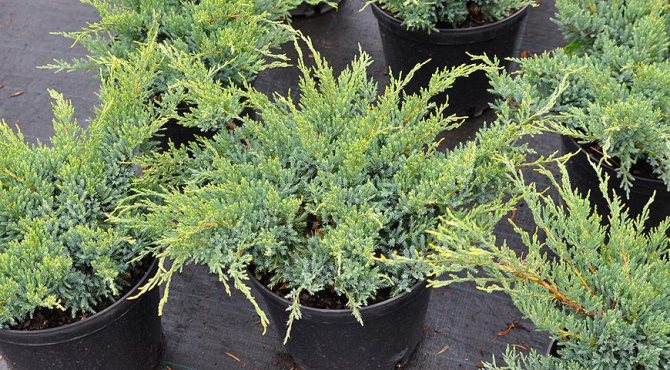

Juniper scaly Holger
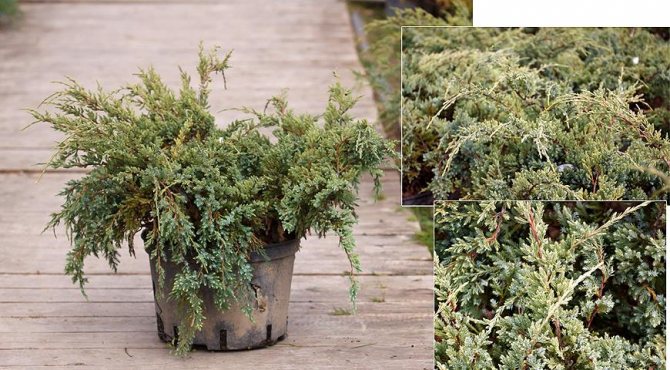

Juniper scaly Holger
Juniper scaly Meyeri
Erect shrub. The needles are silver-blue.
External features
A creeping shrub, may have ascending branches covered with light gray bark, which stratifies in some areas. Shoots are tetrahedral, thin. Needles of different shapes are formed on them.
Needle-shaped - grows opposite and criss-cross at the very bottom of the shoot. It is very delicate, thin, painted in a bright green color, no more than 0.8 cm long. It departs slightly from the shoot and has sharp tips.
Scaly needles grow at the ends of the shoots. It is tightly pressed against them, has a rhombic shape, gray-green in color. In winter, this type of needles turns brown.
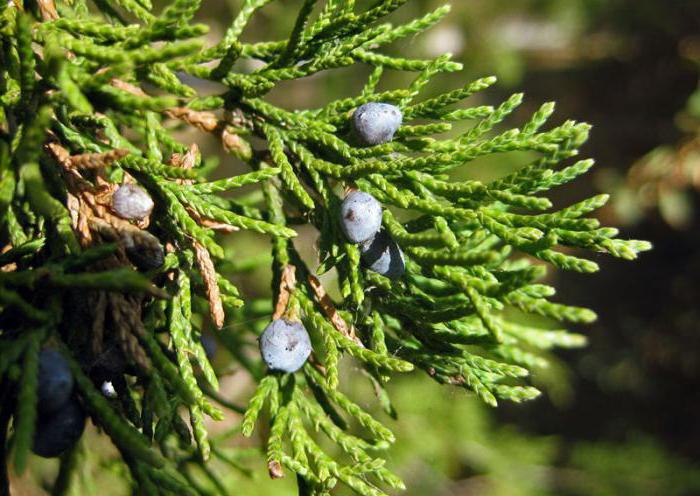

Care
In order for the Daurian juniper to develop normally, in the spring it must be fed with nitroammophos at the rate of 30 g / m².The plant does not tolerate dry air, it develops better on soils of medium moisture. In a very dry and hot summer, watering is recommended, but not more than 3 times per season, and weekly spraying, which is carried out in the evening after sunset.
Loosening is carried out shallow immediately after watering and weeding, this is especially important for young plantings. For mulching, peat, wood chips or sawdust are used in a layer of about 8 centimeters. This must be done immediately after planting.
Pruning, shearing depends on the place of cultivation and the type of plant. Basically, these procedures are aimed at removing dry branches. Juniper of this species does not need shelter for the winter. The only exception is the first winter after planting, especially in the northern regions.
Recumbent juniper (Juniperus procumbens)
The plant is native to Japan. Creeping dioecious shrub with open branches, 0.2–0.5 m high, crown diameter up to 2–4 m. The needles are bluish-green. The cones are round, blackish-brown with a pale blue waxy bloom. Can be grafted onto a stem. Used for clipping bonsai.
Juniper recumbent Nana
Japanese variety. A creeping shrub, with a dense crown up to 0.4 m high and a crown diameter up to 1–1.5 m. The needles are bluish-green.
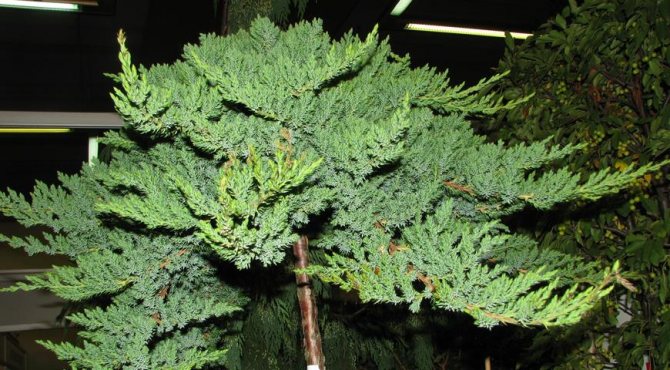

Juniper recumbent Nana on a trunk

